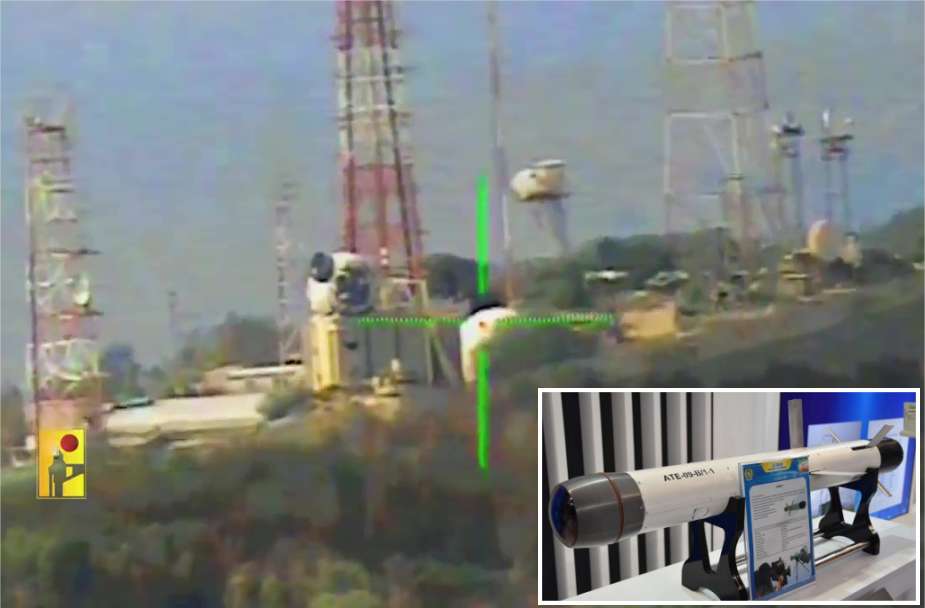- Army
- Conflicts in the world
- Israel - Iran conflict 2025
- Pakistan - India Conflict 2025
- Russia Ukraine War 2022
- Libya conflict day by day
- HAMAS - Israel War 2023
- Operation Serval in Mali French Army
- Sangaris operation Central African Republic
- Sangaris opération militaire République Centreafrique
- Ukraine - Russia conflict
- Syria conflict news
- Defence & Security Industry Technology
- Armies in the world
- Analysis Defense and Security Industry
- Conflicts in the world
- Navy
- Air
Hezbollah uses Iranian Almas 1 missiles against Israeli military sites
On January 26 and 29, 2024, the armed wing of Lebanese Hezbollah released video footage unveiling the use of third-generation Iranian Almas-1 anti-tank guided missiles (ATGMs) against military equipment belonging to the Israel Defense Forces (IDF). The Almas ATGM is equipped with a combined television and thermal imaging guidance system, indicating an advancement in Hezbollah's military capabilities.
Follow Army Recognition on Google News at this link

Hezbollah released video footage confirming the use of Iranian Almas-1 anti-tank guided missiles (ATGMs) against Israeli military equipment. (Picture source: Russian social media and Army Recognition)
The first released video footage, on January 26, 2024, shows the missile striking a target beneath what appears to be a protective dome shielding radar or radio equipment at an Israeli military site located at Jal el-Allam near the Lebanon-Israel border. Lebanese militants have described it as an employment of "special missile weapons," claiming to have engaged the Israeli equipment from a distance exceeding 2.5 km. This suggests that Hezbollah may have obtained several Iranian Almas ATGMs, believed to be replicas of the Israeli Spike ATGM. This marks the first concrete evidence of Hezbollah employing a Non-Line of Sight (NLOS) missile system in combat.
On January 29, 2024, another video became available, providing additional evidence of Hezbollah's potential ownership of several Iranian Almas-1 ATGMs. In this footage, Hezbollah executed another attack near Ras Naqura, during which they used the Almas-1 missile to target an Israeli radar.
The Almas missile system is available in two versions: one designed for airborne use, often integrated into helicopters and unmanned aerial vehicles, known as Almas-3, and a ground-based variant equipped with a portable launcher known as Almas 1. The ground-based Almas-1 ATGM was publicly unveiled in July 2021, indicating its growing importance in Iranian-linked military arsenals.
The Iranian Almas anti-tank guided missile (ATGM) is said to be a third-generation ATGM. Third-generation ATGMs rely on a laser, electro-optical imager (IIR) seeker, or a W band radar seeker in the nose of the missile. Once the target is identified, the missile requires no further guidance during flight; it is "fire-and-forget," and the missile operator is free to retreat. However, fire-and-forget missiles are susceptible to electronic countermeasures compared to manual command-to-line of sight (MCLOS) and semi-automatic command-to-line-of-sight (SACLOS) ATGMs.
Most third-generation ATGMs feature shaped charge High Explosive Anti-Tank (HEAT) warheads, designed specifically for penetrating tank armor. Some employ tandem-charge warheads to defeat explosive reactive armor (ERA), while others are top-attack weapons designed to strike vehicles from above, where their armor is generally weaker. Examples of third-generation ATGMs include the German PARS 3 LR, the US FGM-148 Javelin, the Chinese HJ-12, and the Israeli Spike.

At the Partner 2023 exhibition in Serbia, the Iranian Ministry of Defence showcased the Almas 1 ATGM, a part of the Almas family of Iranian multipurpose weapon systems. (Picture source: Army Recognition)
The Almas-1 features an optical-electronic TV/IR homing head and incorporates a command-telemetry channel, enabling launches from concealed positions with trajectory correction via radio signals. This feature allows the operator to potentially retarget the missile mid-flight, similar to the capabilities of the Israeli Spike-ER and the French MMP Akeron ATGMs.
The Almas 1, as the second member of the Almas family, has been designed for use in urban warfare, ground support, and special missions. Designers have placed emphasis on survivability during operations, incorporating features such as an imaging seeker and a fiber-optical data link, which enable the operator to observe and update the missile's trajectory during its flight. These capabilities offer advantages such as the ability to switch targets after launch, target concealed enemy positions, achieve precision in urban warfare, conduct real-time surveillance and damage assessment, extend its range, ensure accuracy, and reduce collateral damage. Additionally, the missile can be aborted after launch for added flexibility.
The Almas 1 can operate in two modes: 'fire and forget' mode, like the FGM-148 Javelin, or 'fire, observe, and update' mode. It has a range spanning from 200 to 4000 meters and features a tandem warhead with shaped charges or thermobaric components, providing a minimum penetration depth of 600 mm of rolled homogeneous steel. While specific penetration capabilities for the Javelin's warhead remain classified, US military training documents suggest that it can penetrate all known armor, including more than 762 mm of rolled homogeneous steel.
In terms of specifications, the Almas 1 measures 1,100 mm in length and has a diameter of 130 mm. It is launched from a light tripod and relies on a visible image seeker and double-point guidance for precision targeting. The system components have specific weights - the missile round weighs 15 kilograms, the firing post 11.5 kilograms, and the tripod 3.5 kilograms. In contrast, the FGM-148 Javelin is notably heavier, with a weight of approximately 22.3 kg when accounting for its launch tube and Command Launch Unit (CLU). Both Iranian and US ATGMs can follow either a direct or lofted flight trajectory, allowing them to exploit the generally weaker armor on the top of tanks.


























